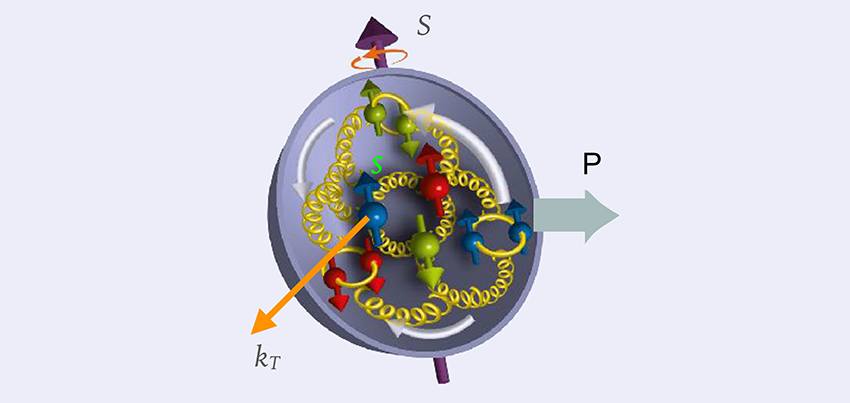SPD detector at NICA: talking simply about complex facility
News, 19 January 2021
The JINR Programme Advisory Committee for Particle Physics at the meeting on 18 January considered the conceptual design of the second detector of the NICA collider, namely the SPD detector for studies of the spin of particles.
Head of the Department of the Laboratory of Nuclear Problems Alexey Guskov presented the conceptual design of the SPD detector (Spin Physics Detector) to the members of the Programme Advisory Committee (PAC). He led the preparation of the SPD experiment and the creation of an international collaboration of this experiment.
The SPD detector is being created as a universal setup for the comprehensive study of gluons in protons and deuterons, according to the design of this detector. Sounds complicated.
However, let’s have a look at the symbolic picture (above) depicting gluons in protons and deuterons and try to break this complex statement into simple parts.
The picture expressively shows us a proton in the section, i.e. its rich inner world.
So, protons are nuclei of hydrogen. They consist of quarks and gluons. Quarks are red, blue, and green balls in the picture. Gluons may look like yellow springs and resemble macaroni spirals.
Gluons glue quarks inside protons so tightly that quarks are not able to escape protons into a gluon-free existence. The tension force of spring macaroni spirals between quarks is several tons. The entire mass of the visible part of the Universe is in the energy of gluons. Quarks, on the contrary, are very light.
Quarks and gluons are elementary particles. They do not have constituent parts.
Previously, protons were thought to have three quarks and nothing else. These quarks are depicted in the picture as large balls.
Later on, specialists found out that in addition to these three quarks, the proton has a number of quark-antiquarks pairs, i.e. pairs of small balls of the same colour in the picture. It was also discovered that all these quarks, both paired and unpaired, are bound by macaroni gluons.
The arrows coming out of the quark-balls up and down indicate the quark spin. Spin is one of the two characteristics that describe the orientation of a particle in space, as far as it is impossible to indicate coordinates of a particle. (The second characteristic is the particle’s momentum.)
Now, let’s talk about deuterons. The deuteron is the nucleus of hydrogen-2 (2Н), i.e. a chemical element the nucleus of which contains the same number of protons as that of hydrogen-1(1Н) – one proton. In addition to the proton, the hydrogen-2 nucleus has one more neutron. One proton plus one neutron equals to two particles in the nucleus of hydrogen-2. That is why hydrogene-2 but not hydrogene-1. Hydrogen-2 was called deuterium, from the Greek word “deuteros” meaning “the second”.
There is also hydrogen-3 by the way. Have you guessed why it is hydrogen-3? Well, yes, two neutrons were added to the proton of hydrogen-1, and a nucleus containing three particles was obtained, i.e. the nucleus of hydrogen-3. This hydrogen-3 was called tritium, from the Greek word “tritos” meaning “the third”.
Now about spin. This term was introduced in science in the 1920s. But it still remains mysterious in many ways. Spin by its definition shows rotational characteristics of a particle or a system of particles. However, it does not mean that the particle rotates in the conventional sense. Its rotation is imaginary, it exists as a property of the particle which is convenient to be described mathematically as the rotation of the particle around its own axis. It is made for harmony and consistency of the physical theory. But this imaginary rotation affects the interaction of particles as if they truly rotate. Everyone knows that twisted tennis or volleyball ball flies in the direction no one can expect of it. The same is true for particles. That is why it is so important to understand the properties of the particle’s spin. Things we do not even know about depend on it.
And here is the SPD detector, a spin physics detector, which will study the things we do not know about the mysterious spin of mysterious macaroni gluons in nuclei of the simplest chemical elements, namely hydrogen and its deuterium isotopes. The SPD experiment will find out how the spin and the momentum of gluons, which carry the entire mass of the visible universe, is distributed.
We will discuss the SPD detector’s construction next time.
Natalia Teryaeva
